Carbon Fiber Reinforced Plastics Based on an Epoxy Binder with the Effect of Thermally Induced Self-Repair
Abstract
1. Introduction
2. Materials and Methods
2.1. Materials
2.2. Preparation of Polymer Mixtures
2.3. CFRP Production
2.4. Characterization and Measurement
3. Results and Discussion
3.1. Thermal Properties
3.2. Evaluation of the Degree of Recovery of CFRP by the DMA Method
3.3. Evaluation of the Degree of Recovery of Carbon Plastics during Delamination of a Macrosample
3.4. X-ray Tomography of CFRP
4. Conclusions
Author Contributions
Funding
Institutional Review Board Statement
Informed Consent Statement
Data Availability Statement
Conflicts of Interest
References
- Zhang, M.; Rong, M. Design and synthesis of self-healing polymers. Sci. China Chem. 2012, 55, 648–676. [Google Scholar] [CrossRef]
- Zhang, Z.P.; Rong, M.Z.; Zhang, M.Q. Polymer engineering based on reversible covalent chemistry: A promising innovative pathway towards new materials and new functionalities. Prog. Polym. Sci. 2018, 80, 39–93. [Google Scholar] [CrossRef]
- Nik Md Noordin Kahar, N.N.F.; Osman, A.F.; Alosime, E.; Arsat, N.; Mohammad Azman, N.A.; Syamsir, A.; Itam, Z.; Abdul Hamid, Z.A. The Versatility of Polymeric Materials as Self-Healing Agents for Various Types of Applications: A Review. Polymers 2021, 13, 1194. [Google Scholar] [CrossRef]
- Teixeira, R.F.A.; Hillewaere, X.K.D.; Billiet, S.; Du Prez, F.E. Chemistry of Crosslinking Processes for Self-Healing Polymers. Macromol. Rapid Commun. 2013, 34, 290–309. [Google Scholar] [CrossRef]
- Zhai, L.; Narkar, A.; Ahn, K. Self-healing polymers with nanomaterials and nanostructures. Nano Today 2020, 30, 100826. [Google Scholar] [CrossRef]
- Wang, Y.; Pham, D.T.; Ji, C. Nanocomposites for Extrinsic Self-healing Polymer Materials. In Smart Polymer Nanocomposites: Energy Harvesting, Self-Healing and Shape Memory Applications; Ponnamma, D., Sadasivuni, K.K., Cabibihan, J.-J., Al-Maadeed, M.A.-A., Eds.; Springer International Publishing: Cham, Switzerland, 2017; pp. 243–279. [Google Scholar] [CrossRef]
- Utrera-Barrios, S.; Verdejo, R.; López-Manchado, M.A.; Hernández Santana, M. Evolution of self-healing elastomers, from extrinsic to combined intrinsic mechanisms: A review. Mater. Horiz. 2020, 7, 2882–2902. [Google Scholar] [CrossRef]
- Wang, X.; Zhao, K.; Huang, X.; Ma, X.; Wei, Y. Preparation and properties of self-healing polyether amines based on Diels–Alder reversible covalent bonds. High Perform. Polym. 2019, 31, 51–62. [Google Scholar] [CrossRef]
- Beljaars, M.; Heeres, H.J.; Broekhuis, A.A.; Picchioni, F. Bio-Based Aromatic Polyesters Reversibly Crosslinked via the Diels–Alder Reaction. Appl. Sci. 2022, 12, 2461. [Google Scholar]
- Liu, Y.-L.; Chuo, T.-W. Self-healing polymers based on thermally reversible Diels–Alder chemistry. Polym. Chem. 2013, 4, 2194–2205. [Google Scholar] [CrossRef]
- Gandini, A. The furan/maleimide Diels–Alder reaction: A versatile click–unclick tool in macromolecular synthesis. Prog. Polym. Sci. 2013, 38, 1–29. [Google Scholar] [CrossRef]
- Lee, Y.-H.; Zhuang, Y.-N.; Wang, H.-T.; Wei, M.-F.; Ko, W.-C.; Chang, W.-J.; Way, T.-F.; Rwei, S.-P. Fabrication of Self-Healable Magnetic Nanocomposites via Diels–Alder Click Chemistry. Appl. Sci. 2019, 9, 506. [Google Scholar] [CrossRef]
- Tian, Q.; Yuan, Y.C.; Rong, M.Z.; Zhang, M.Q. A thermally remendable epoxy resin. J. Mater. Chem. 2009, 19, 1289–1296. [Google Scholar] [CrossRef]
- Coope, T.; Turkenburg, D.; Fischer, H.; Luterbacher, R.; Bracht, H.; Bond, I. Novel Diels-Alder based self-healing epoxies for aerospace composites. Smart Mater. Struct. 2016, 25, 084010. [Google Scholar] [CrossRef]
- Turkenburg, D.H.; Fischer, H.R. Diels-Alder based, thermo-reversible cross-linked epoxies for use in self-healing composites. Polymer 2015, 79, 187–194. [Google Scholar] [CrossRef]
- Wu, D.Y.; Meure, S.; Solomon, D. Self-healing polymeric materials: A review of recent developments. Prog. Polym. Sci. 2008, 33, 479–522. [Google Scholar] [CrossRef]
- Perin, D.; Odorizzi, G.; Dorigato, A.; Pegoretti, A. Development of Polyamide 6 (PA6)/Polycaprolactone (PCL) Thermoplastic Self-Healing Polymer Blends for Multifunctional Structural Composites. Appl. Sci. 2022, 12, 12357. [Google Scholar] [CrossRef]
- Oh, C.-R.; Lee, D.-I.; Park, J.-H.; Lee, D.-S. Thermally Healable and Recyclable Graphene-Nanoplate/Epoxy Composites via an In-Situ Diels-Alder Reaction on the Graphene-Nanoplate Surface. Polymers 2019, 11, 1057. [Google Scholar] [CrossRef] [PubMed]
- Wu, P.; Liu, L.; Wu, Z. Synthesis of Diels-Alder Reaction-Based Remendable Epoxy Matrix and Corresponding Self-healing Efficiency to Fibrous Composites. Macromol. Mater. Eng. 2020, 305, 2000359. [Google Scholar] [CrossRef]
- Chen, X.; Dam, M.A.; Ono, K.; Mal, A.; Shen, H.; Nutt, S.R.; Sheran, K.; Wudl, F. A Thermally Re-mendable Cross-Linked Polymeric Material. Science 2002, 295, 1698–1702. [Google Scholar] [CrossRef]
- Khan, N.I.; Halder, S.; Wang, J. Diels-Alder based epoxy matrix and interfacial healing of bismaleimide grafted GNP infused hybrid nanocomposites. Polym. Test. 2019, 74, 138–151. [Google Scholar] [CrossRef]
- Kuang, X.; Liu, G.; Dong, X.; Liu, X.; Xu, J.; Wang, D. Facile fabrication of fast recyclable and multiple self-healing epoxy materials through diels-alder adduct cross-linker. J. Polym. Sci. Part A Polym. Chem. 2015, 53, 2094–2103. [Google Scholar] [CrossRef]
- Tian, Q.; Rong, M.Z.; Zhang, M.Q.; Yuan, Y.C. Synthesis and characterization of epoxy with improved thermal remendability based on Diels-Alder reaction. Polym. Int. 2010, 59, 1339–1345. [Google Scholar] [CrossRef]
- Tian, Q.; Rong, M.Z.; Zhang, M.Q.; Yuan, Y.C. Optimization of thermal remendability of epoxy via blending. Polymer 2010, 51, 1779–1785. [Google Scholar] [CrossRef]
- McReynolds, B.T.; Mojtabai, K.D.; Penners, N.; Kim, G.; Lindholm, S.; Lee, Y.; McCoy, J.D.; Chowdhury, S. Understanding the Effect of Side Reactions on the Recyclability of Furan–Maleimide Resins Based on Thermoreversible Diels–Alder Network. Polymers 2023, 15, 1106. [Google Scholar] [CrossRef]
- Czifrak, K.; Lakatos, C.; Karger-Kocsis, J.; Daróczi, L.; Zsuga, M.; Keki, S. One-Pot Synthesis and Characterization of Novel Shape-Memory Poly(ε-Caprolactone) Based Polyurethane-Epoxy Co-networks with Diels–Alder Couplings. Polymers 2018, 10, 504. [Google Scholar] [CrossRef] [PubMed]
- Kotrotsos, A.; Rouvalis, C.; Geitona, A.; Kostopoulos, V. Toughening and Healing of CFRPs by Electrospun Diels–Alder Based Polymers Modified with Carbon Nano-Fillers. J. Compos. Sci. 2021, 5, 242. [Google Scholar] [CrossRef]
- Solodilov, V.I.; Bazhenov, S.L.; Gorbatkina, Y.A.; Kuperman, A.M. Determination of the Interlaminar Fracture Toughness of Glass-Fiber-Reinforced Plastics on Ring Segments. Mech. Compos. Mater. 2003, 39, 407–414. [Google Scholar] [CrossRef]
- Dolci, E.; Michaud, G.; Simon, F.; Boutevin, B.; Fouquay, S.; Caillol, S. Remendable thermosetting polymers for isocyanate-free adhesives: A preliminary study. Polym. Chem. 2015, 6, 7851–7861. [Google Scholar] [CrossRef]
- Hardis, R.; Jessop, J.L.P.; Peters, F.E.; Kessler, M.R. Cure kinetics characterization and monitoring of an epoxy resin using DSC, Raman spectroscopy, and DEA. Compos. Part A Appl. Sci. Manuf. 2013, 49, 100–108. [Google Scholar] [CrossRef]
- Fortunato, G.; Anghileri, L.; Griffini, G.; Turri, S. Simultaneous Recovery of Matrix and Fiber in Carbon Reinforced Composites through a Diels–Alder Solvolysis Process. Polymers 2019, 11, 1007. [Google Scholar] [CrossRef]
- Liu, Y.-L.; Hsieh, C.-Y. Crosslinked epoxy materials exhibiting thermal remendablility and removability from multifunctional maleimide and furan compounds. J. Polym. Sci. Part A Polym. Chem. 2006, 44, 905–913. [Google Scholar] [CrossRef]
- Al-Zubaidy, H.; Zhao, X.-L.; Al-Mihaidi, R. Mechanical Behaviour of Normal Modulus Carbon Fibre Reinforced Polymer (CFRP) and Epoxy under Impact Tensile Loads. Procedia Eng. 2011, 10, 2453–2458. [Google Scholar] [CrossRef]
- Suvorova, Y.V.; Sorina, T.G.; Gunyaev, G.M. Rate dependences of the strength of carbon-fiber-reinforced plastics. Mech. Compos. Mater. 1991, 26, 480–484. [Google Scholar] [CrossRef]
- Harding, J.; Welsh, L.M. A tensile testing technique for fibre-reinforced composites at impact rates of strain. J. Mater. Sci. 1983, 18, 1810–1826. [Google Scholar] [CrossRef]
- Ding, S.; Zhang, J.; Zhou, L.; Luo, Y. Promoting healing progress in polymer composites based on Diels-Alder reaction by constructing silver bridges. Polym. Adv. Technol. 2021, 32, 1239–1250. [Google Scholar] [CrossRef]
- Sørensen, B.F.; Jacobsen, T.K. Large-scale bridging in composites: R-curves and bridging laws. Compos. Part A Appl. Sci. Manuf. 1998, 29, 1443–1451. [Google Scholar] [CrossRef]
- Solodilov, V.I.; Korokhin, R.A.; Gorbatkina, Y.A.; Kuperman, A.M. Comparison of Fracture Energies of Epoxy-polysulfone Matrices and Unidirectional Composites Based on Them. Mech. Compos. Mater. 2015, 51, 177–190. [Google Scholar] [CrossRef]
- Jacobsen, T.K.; Sørensen, B.F. Mode I intra-laminar crack growth in composites-modelling of R-curves from measured bridging laws. Compos. Part A Appl. Sci. Manuf. 2001, 32, 1–11. [Google Scholar] [CrossRef]
- Korokhin, R.A.; Solodilov, V.I.; Zvereva, U.G.; Solomatin, D.V.; Gorbatkina, Y.A.; Shapagin, A.V.; Lebedeva, O.V.; Bamborin, M.Y. Epoxy polymers modified with polyetherimide. Part II: Physicomechanical properties of modified epoxy oligomers and carbon fiber reinforced plastics based on them. Polym. Bull. 2020, 77, 2039–2057. [Google Scholar] [CrossRef]
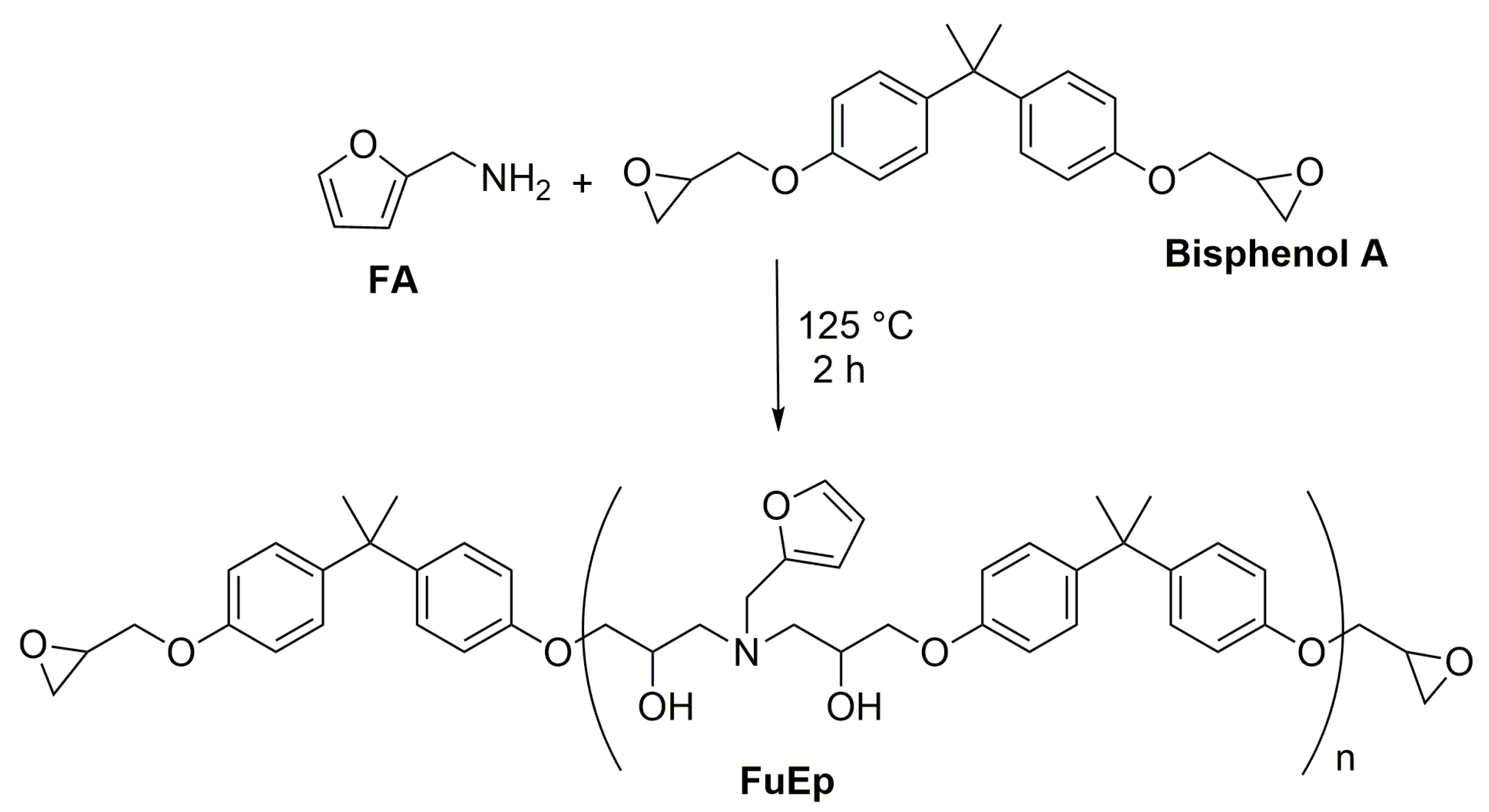

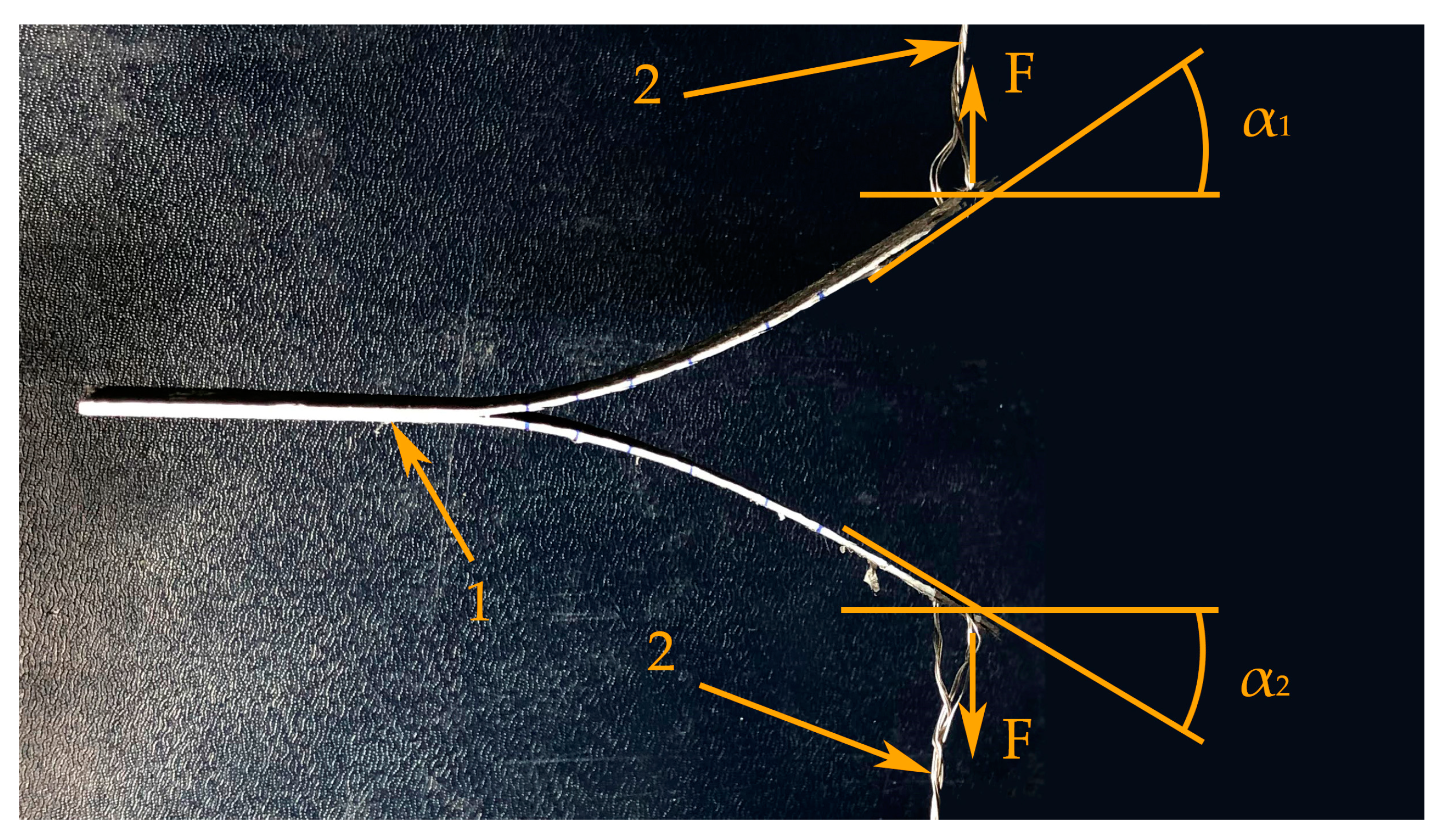


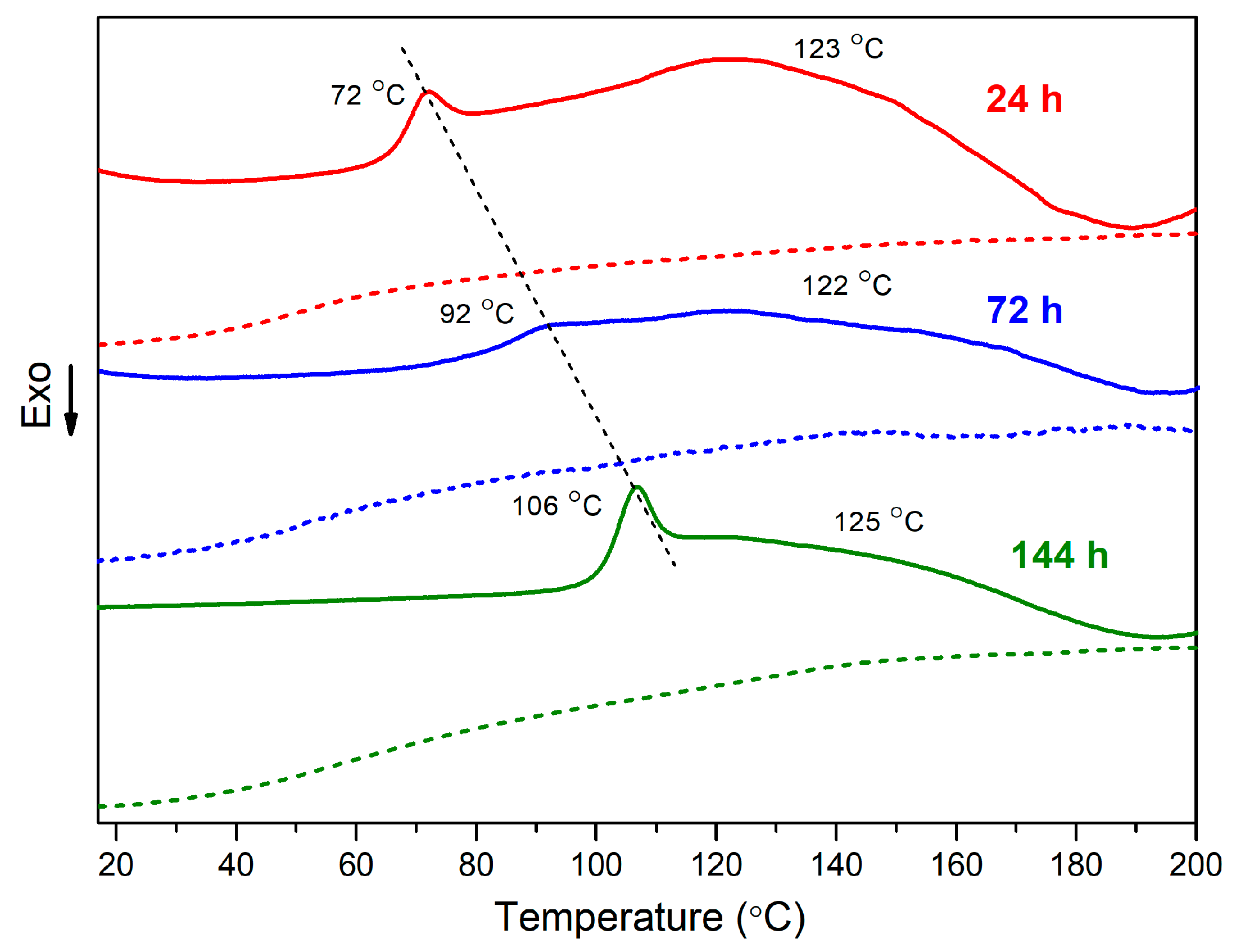
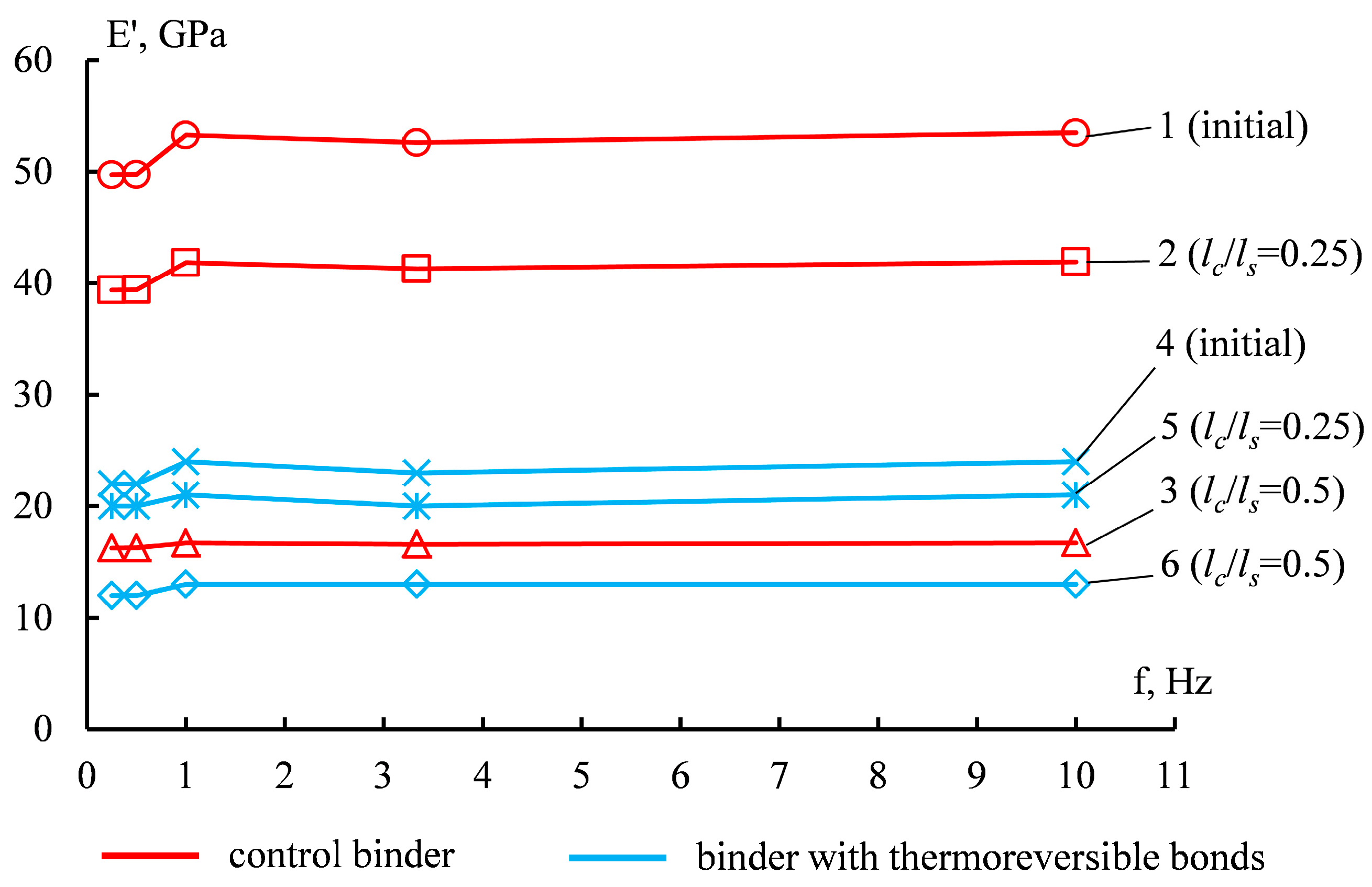
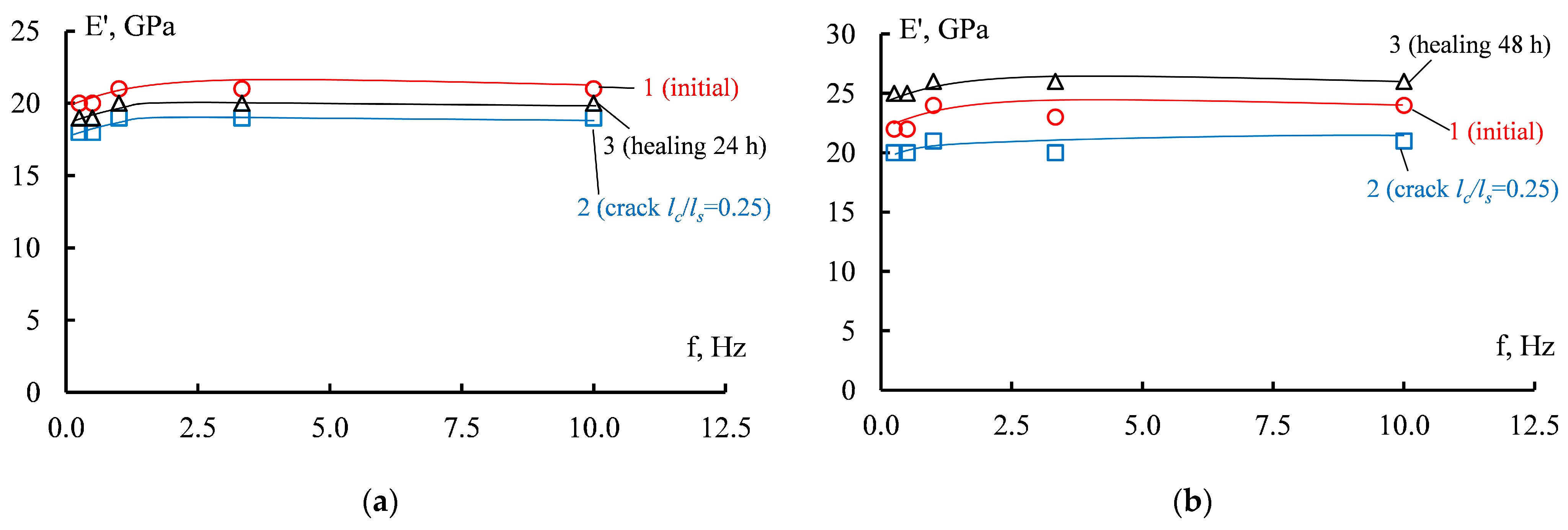
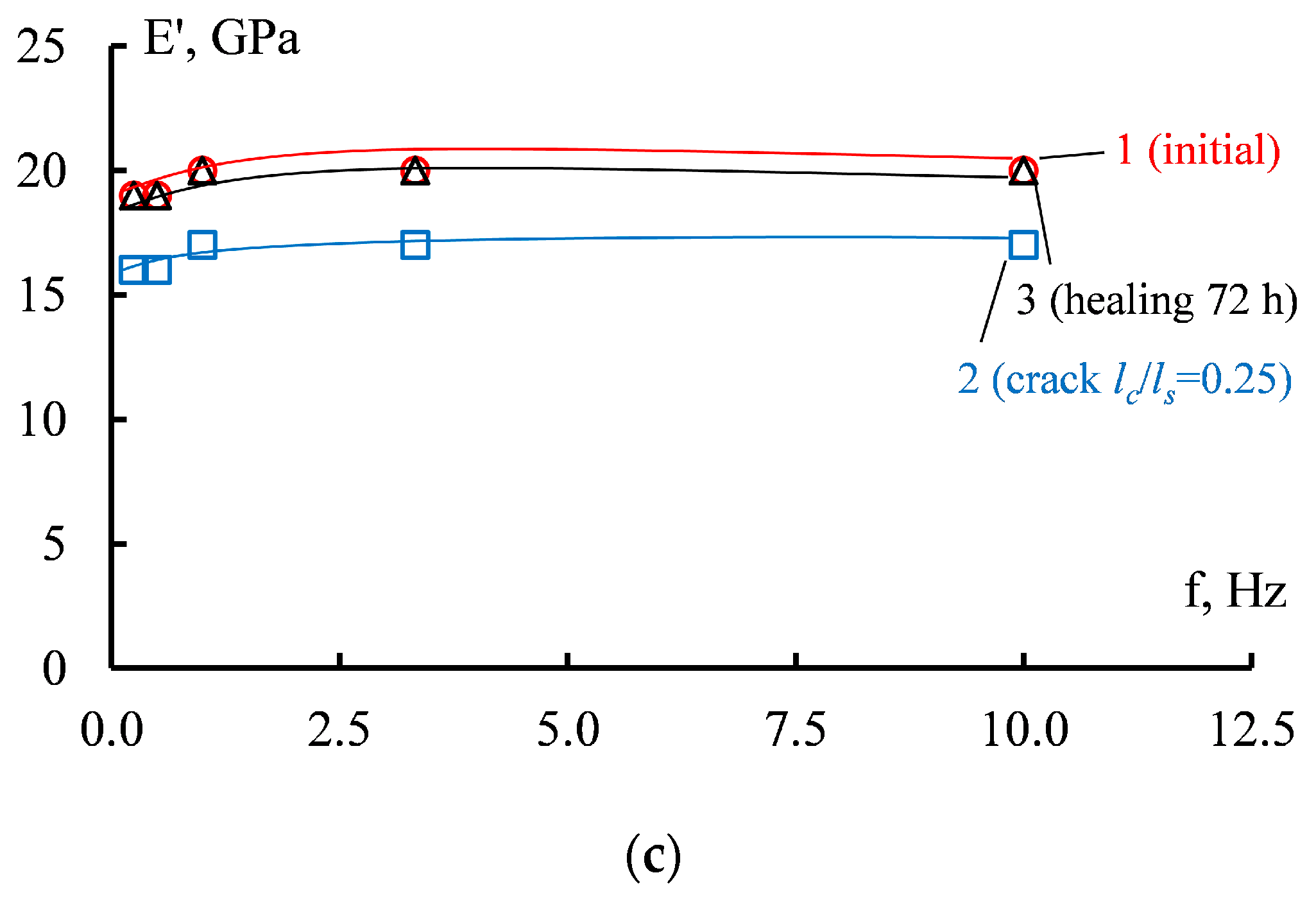
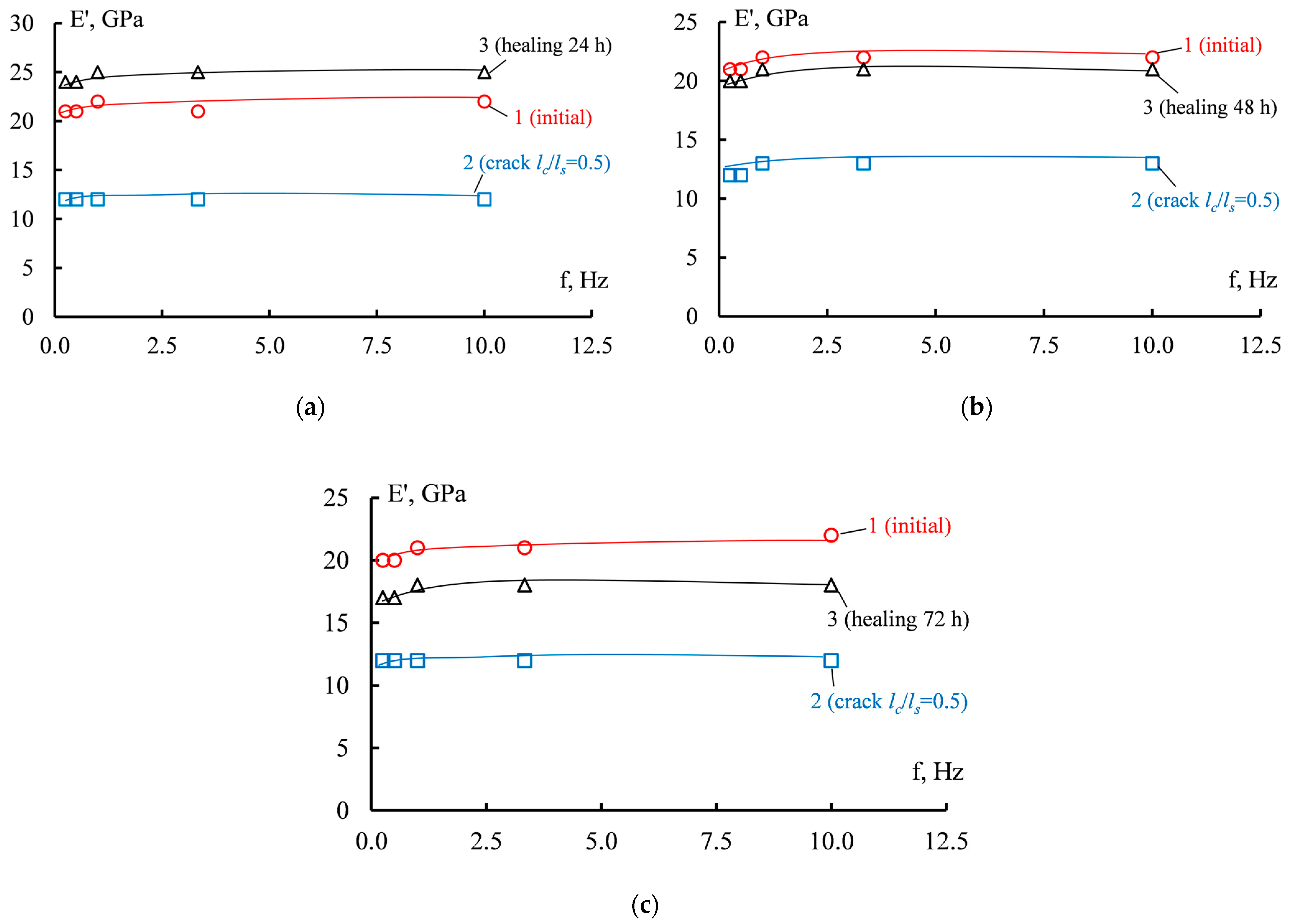

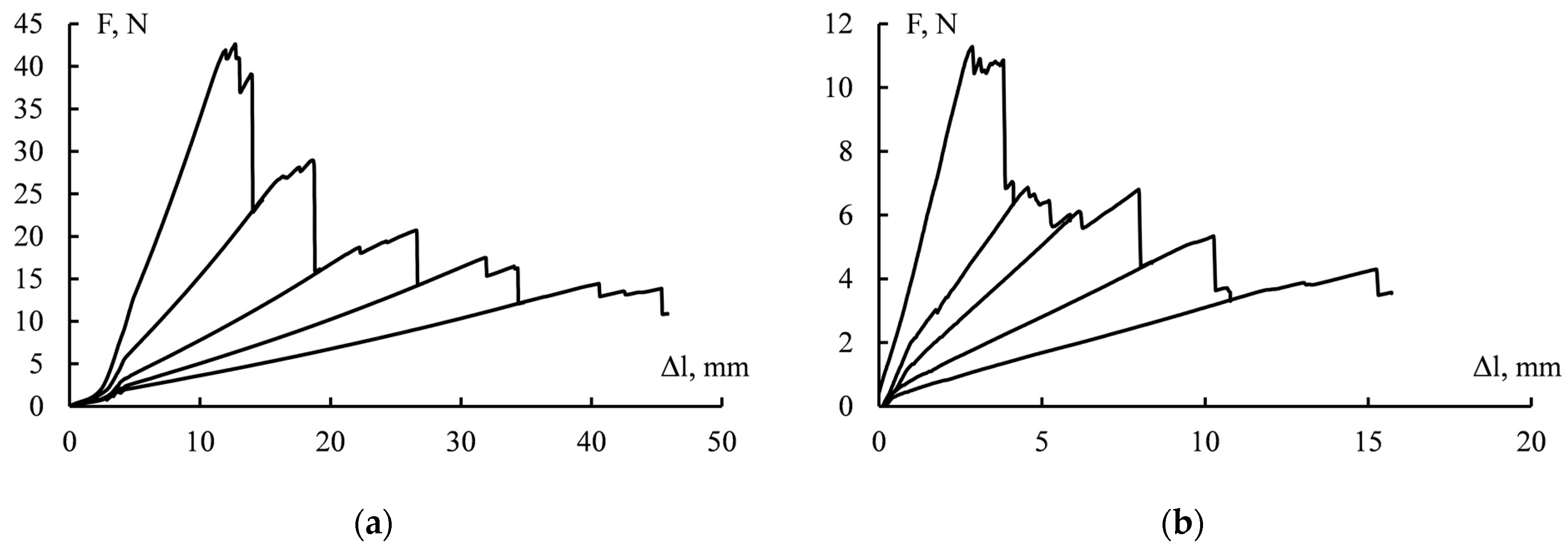

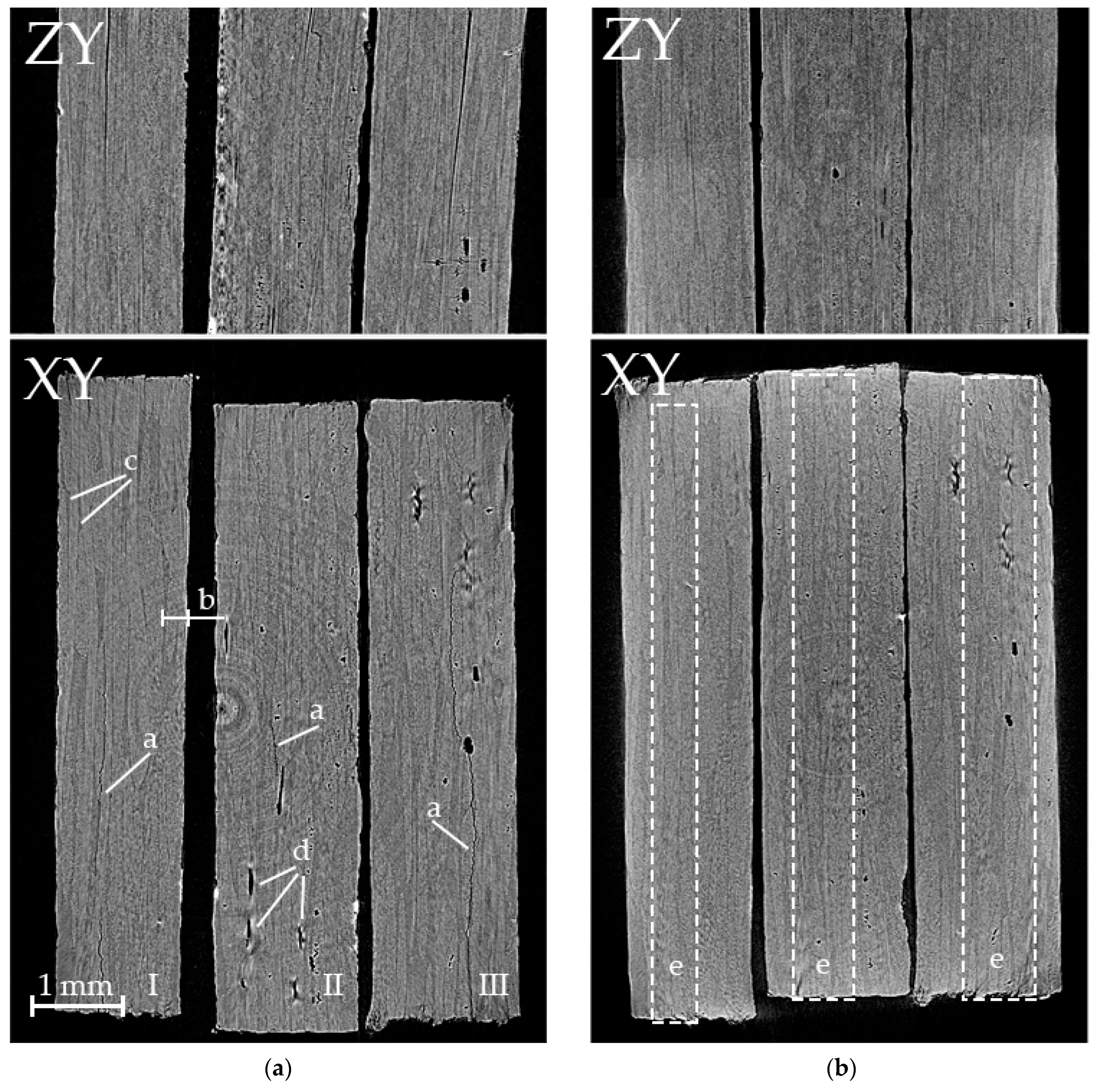

| Curing Time (80 °C), h | Td5%, °C | Td10%, °C | Tdmax, °C | Residue (wt%) |
|---|---|---|---|---|
| 24 | 191 | 249 | 377 | 21 |
| 72 | 212 | 274 | 382 | 17 |
| 144 | 237 | 289 | 375 | 22 |
| Relative Crack Length | Heat Treatment Time at 80 °C, h | ||
|---|---|---|---|
| 24 | 48 | 72 | |
| 0.25 | 91 | 118 | 91 |
| 0.5 | 114 | 96 | 82 |
| CFRP Type | CFRP without Self-Healing Effect | CFRP with Self-Healing Effect | CFRP with Self-Healing Effect after Crack Healing |
|---|---|---|---|
| GIR, kJ/m2 | 0.41 ± 0.03 | 0.70 ± 0.08 | 0.05 ± 0.02 |
| CFRP Type | CFRP without Self-Healing Effect | CFRP with Self-Healing Effect | CFRP with Self-Healing Effect after Crack Healing |
|---|---|---|---|
| Porosity, vol.% | 2.5 | 3.1 | 2.7 |
Disclaimer/Publisher’s Note: The statements, opinions and data contained in all publications are solely those of the individual author(s) and contributor(s) and not of MDPI and/or the editor(s). MDPI and/or the editor(s) disclaim responsibility for any injury to people or property resulting from any ideas, methods, instructions or products referred to in the content. |
© 2023 by the authors. Licensee MDPI, Basel, Switzerland. This article is an open access article distributed under the terms and conditions of the Creative Commons Attribution (CC BY) license (https://creativecommons.org/licenses/by/4.0/).
Share and Cite
Petrova, T.V.; Tretyakov, I.V.; Kireynov, A.V.; Platonova, E.O.; Ponomareva, P.F.; Alexeeva, O.V.; Solodilov, V.I.; Yurkov, G.Y.; Berlin, A.A. Carbon Fiber Reinforced Plastics Based on an Epoxy Binder with the Effect of Thermally Induced Self-Repair. Appl. Sci. 2023, 13, 6557. https://doi.org/10.3390/app13116557
Petrova TV, Tretyakov IV, Kireynov AV, Platonova EO, Ponomareva PF, Alexeeva OV, Solodilov VI, Yurkov GY, Berlin AA. Carbon Fiber Reinforced Plastics Based on an Epoxy Binder with the Effect of Thermally Induced Self-Repair. Applied Sciences. 2023; 13(11):6557. https://doi.org/10.3390/app13116557
Chicago/Turabian StylePetrova, Tuyara V., Ilya V. Tretyakov, Aleksey V. Kireynov, Elena O. Platonova, Polina F. Ponomareva, Olga V. Alexeeva, Vitaliy I. Solodilov, Gleb Yu. Yurkov, and Alexander Al. Berlin. 2023. "Carbon Fiber Reinforced Plastics Based on an Epoxy Binder with the Effect of Thermally Induced Self-Repair" Applied Sciences 13, no. 11: 6557. https://doi.org/10.3390/app13116557
APA StylePetrova, T. V., Tretyakov, I. V., Kireynov, A. V., Platonova, E. O., Ponomareva, P. F., Alexeeva, O. V., Solodilov, V. I., Yurkov, G. Y., & Berlin, A. A. (2023). Carbon Fiber Reinforced Plastics Based on an Epoxy Binder with the Effect of Thermally Induced Self-Repair. Applied Sciences, 13(11), 6557. https://doi.org/10.3390/app13116557







